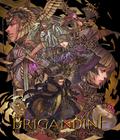Brigandine: The Legend of Runersia is set in the titular land of Runersia, which is a magical land comprised of six nations: Guimoule, the Holy Gustava Empire, the Mana Saleesia Theocracy, Noralezo, The Shinobi Tribes and The United Islands of Mirelva. The power of these nations comes from powerful magic-using rune knights. At the center of each nation is a brigandine, or a magical artifact passed down from ancient times and associated with a virtue: Ego, Freedom, Glory, Justice and Sanctity. Gustava is the only nation without a brigandine but holds its own through sheer determination.
Brigandine allows you to pick any of the six nations, each with its own story and main hero. Regardless of which nation you choose, the plots all start the same way: A series of misfortunes occur, causing each nation to enter a contest to take the other nation's brigandines and unite Runersia under one flag. The plot is revealed through vignettes between various events, and it eventually leads up to a dramatic (and very JRPG) final conflict.
The plot is probably the strongest aspect of Brigandine. The game juggles a large cast of characters well, and it's educational to see events from different viewpoints. Even if you're not playing as a nation, you'll get an epilogue showing what happened to the main characters after you defeated them. There are a lot of events to see, and some involve random knights who you can recruit or specific combinations of characters. Seeing everything will require at least six playthroughs.
Brigandine is effectively a light war game mixed with a JRPG. Once you've chosen your starting nation, you're given an overview of the Runersia landscape. Each significant position is marked, and you're shown the travel lines connecting them. Your goal is to take other nations' lands while protecting your own. You do this by moving your rune knights around the map to attack and guard. Generally, you'll want strong defensive forces positioned at choke points around the map, while a roaming offensive force is good for attacking. It takes a turn to move your units, but units can move anywhere in the territory that you control in that same turn.
It might sound like all you have to do is stick your rune knights at the chokepoints and be done with it, but this is balanced by the quest system. You can take quests as a rune knight to gain extra experience points or a variety of powerful items or monsters. Any rune knight on a quest is not available to defend a location. In addition, each area on the map has its own item pool, so you'll need to move rune knights around to get the best variety of items.
In essence, the balance of the strategy portion of the map is figuring out the bare minimum defenses to protect your choke points while using spare knights to farm up to increase your forces. Since only three knights can battle at a time, you can get by with smaller numbers, but the more knights there are at a location, the less likely the enemy will try to invade. Invasions can be useful for gaining experience points, but they run the risk of wearing down your army or the player's patience.
Whether on the attack or on defense, once a battle begins, you're thrust into the combat screen. Every battle takes place on a large map comprised of hexes, where your units are positioned and can move freely. You can only deploy three rune knights at a time, and the same goes for the enemy. What can really make or break the battle is the rune knight's entourage of monsters.
Each rune knight has a "mana capacity" that you can use prior to battle to assign a squad of monsters to a knight. The monsters all act on the same turn as your rune knight and effectively serve as additional soldiers. They can even level up and wear equipment. More powerful monsters take up more mana capacity, so there is a balance between numbers and power when selecting your monsters. A single dragon is an incredibly strong force on the battlefield, but two centaurs offer more flexibility and range. Monsters can be gained by summoning "stores" at each location, quests, and captured from defeated opponents.
Monsters are risky as well. If a rune knight is defeated in battle, all of their summoned monsters will go with them. While this can be useful for quickly trimming down enemy forces, it means a wrong position can cause you to lose a big chunk of your army. The other risk is that monsters are more like XCOM soldiers than your JRPG protagonist rune knights. If they die in battle, they are gone for good. This is fine in the early game, since low-level monsters can be resummoned relatively easily, but once you get powerful monsters, it can be pretty painful to lose them. You can revive a dead monster using a Revival Stone, which is random loot from quests, so you can't rely on them.
The actual battles play out in standard strategy-RPG fashion. Each rune knight takes a turn to mov. A knight or monster can move and attack in the same turn, but many of their best moves can only be used if you haven't moved yet. Your goal is to defeat the enemy rune knights by draining their HP or forcing them to retreat. Whoever is left standing at the end of the battle wins. If you were invading, then you take control of the land, and if you were defending, then you retain control instead.
The strategic element comes largely from deciding priorities. Enemy monsters are worth a lot of experience points, and killing them is one of the best ways to level up. However, the more time you spend killing monsters, the greater the risk of one of your own dying. Likewise, enemies will retreat if things look bad. This can be useful if you're just defending a base but painful if you're invading. A retreating rune knight remains available to defend their own lands in the next battles, while defeating one in battle wounds them and takes time to recover. If all you want to do is win the battle, you'll charge for the rune knights ASAP, but if you want experience points, you'll need to balance monster killing with not letting knights retreat.
While Brigandine has a ton of story content, the biggest problem I ran into is that there isn't enough content in the gameplay. There's a small selection of character classes and monsters, and once you get a solid team together, you're probably not going to deviate much. In theory, you'd want to create different teams for different environments, but frankly, that seems like more trouble than it is worth. I found myself having more luck just leveling characters and equipping them with items. On the rare occasion I had to heavily worry about an element or environment, I was overflowing with equipment that let me change the element or environment type.
This is a problem because you'll participate in dozens of battles over the course of a single run — more, if you end up getting invaded a lot. At first, it's pretty intense, and you'll find yourself sacrificing weak monsters in order to make sure your valuable ones survive. Once you get going, you'll probably end up making two teams of three characters each and using everyone else you recruit as an item or XP farm. On the easiest difficulty, there isn't much to stop you from sitting still and farming for days. Harder difficulties institute a time limit and objectives, but that only makes "farms" and smaller heavy combat groups more effective, not less.
The diversity is also hurt by the fact that there's a significant disparity between unit types. The mermaid units excel in water, but even water-heavy maps tend to have lots of non-water spaces, and since their spells are heavily penalized when they're not cast in the water, you're better off bringing a flying unit instead. Support units suffer heavily from the fact that very few spells can be cast post-movement, so unless you're turtling to defend your base during an invasion, it usually isn't worth the trouble. Likewise, debuffs are very powerful, but since every single healing unit has access to a "cure" spell, you're effectively trading one turn to stop an enemy from healing in the next turn — unless you've already killed all of their healers.
On the other hand, reliable heavy damage dealers, especially ones that can attack from a distance, are worth their weight in gold. Being able to take down high-priority targets allows for easy victories, even against overwhelming odds. Since you'll instantly defeat all of a knight's summoned monsters when they are defeated, any problematic monster is best handled by killing their boss. Sometimes, you'll even get insanely powerful monsters out of the deal. While there are a lot of combat options, I had trouble bothering with anything but brute force and healing spells.
This all comes together for a game where you're basically building up the beefiest monsters and then bum-rushing them with your most reliable party members, which are usually (but not always) the ones provided to you by the plot. It can be fun at first, but by the end of my first playthrough, I was bored and resorted to using the Auto Battle and Fast-Forward features, only taking control when I wanted to make sure a knight was prioritized. The fact that none of the nations feel different in combat leads to a repetitive nature that doesn't go well with the "replay to see all of the stories" nature of the game. Even if harder difficulty modes offer a greater challenge, it's mostly in getting your farms up as quickly as possible to beat the time limits and more aggressive AI. There is a super-challenging mode where you can use any combination of knights you've previously won the game with, but even then, it suffers from being repetitive.
Brigandine looks pretty low-budget. Most of the visual charm comes from the wide variety of character portraits and occasional splash scenes, all of which look excellent. I wish there was actual portrait variety, but it's a small complaint. In-game graphics are bare-bones unit models in similar-looking environments. It's playable, but it can make it tough to differentiate units from one another, since everything kind of blends together if they're not a monster unit. The voice acting is generally quite good, but since it's only in Japanese, it may be lost on players who are used to dubs. Likewise, the soundtrack is solid but not exceptional, and there are a couple of standout tracks.
Brigandine: The Legend of Runersia is a firmly average game. The strong plot and interesting artwork are tied to a gameplay system that loses its welcome by the end of one playthrough, never mind six. It's still enjoyable for that one playthrough, but it's difficult to imagine going through the same gameplay over and over again. If it hits for you, then there will be a lot of content to enjoy, but otherwise, Brigandine is not varied enough to keep you going for more than a single playthrough.
Score: 7.0/10
More articles about Brigandine: The Legend of Runersia










 The Brigandine classic game is returning after 20 years with an all-new, turn-based strategy game set in a familiar fantasy world.
The Brigandine classic game is returning after 20 years with an all-new, turn-based strategy game set in a familiar fantasy world.

































